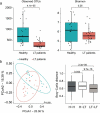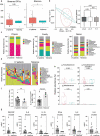A decrease in functional microbiomes represented as Faecalibacterium affects immune homeostasis in long-term stable liver transplant patients
- PMID: 35951731
- PMCID: PMC9377238
- DOI: 10.1080/19490976.2022.2102885
A decrease in functional microbiomes represented as Faecalibacterium affects immune homeostasis in long-term stable liver transplant patients
Abstract
LT, liver transplantation; HCC, hepatocellular carcinoma; IS, immunosuppressants; DC, dendritic cells; Treg, regulatory T; Th17, T helper 17; AST, aspartate transaminase; ALT, alanine transaminase; OUT, operational taxonomic unit; LEfSe, linear discriminant analysis effect size; LDA, linear discriminant analysis; IL, interleukin; TGF, transforming growth factor; GM-CSF, granulocyte-macrophage colony-stimulating factor; IFN, interferon; TNF-α, tumor necrosis factor-α; MIP-1α, macrophage inflammatory protein-1α; IP-10, interferon γ-induced protein; MCP-1, monocyte chemoattractant protein-1; ACR, acute cellular rejection; NF-κB, nuclear factor κB; PT INR, prothrombin time; QC, quality check; PBMC, peripheral blood mononuclear cells; PBS, phosphate-buffered saline; ELISA, enzyme-linked immunosorbent assay.
Keywords: Faecalibacterium; Liver transplantation; bacteroides; gut dysbiosis; gut microbiome; immunosuppressant; regulatory T cells; tolerance.
Conflict of interest statement
All authors disclose no conflicts.
Figures





References
-
- Jain A, Reyes J, Kashyap R, Dodson SF, Demetris AJ, Ruppert K, Abu-Elmagd K, Marsh W, Madariaga J, Mazariegos G, et al. Long-term survival after liver transplantation in 4,000 consecutive patients at a single center. Ann Surg. 2000;232(4):490–500. doi:10.1097/00000658-200010000-00004. - DOI - PMC - PubMed
Publication types
MeSH terms
Substances
LinkOut - more resources
Full Text Sources
Other Literature Sources
Medical
Molecular Biology Databases
Research Materials
Miscellaneous
